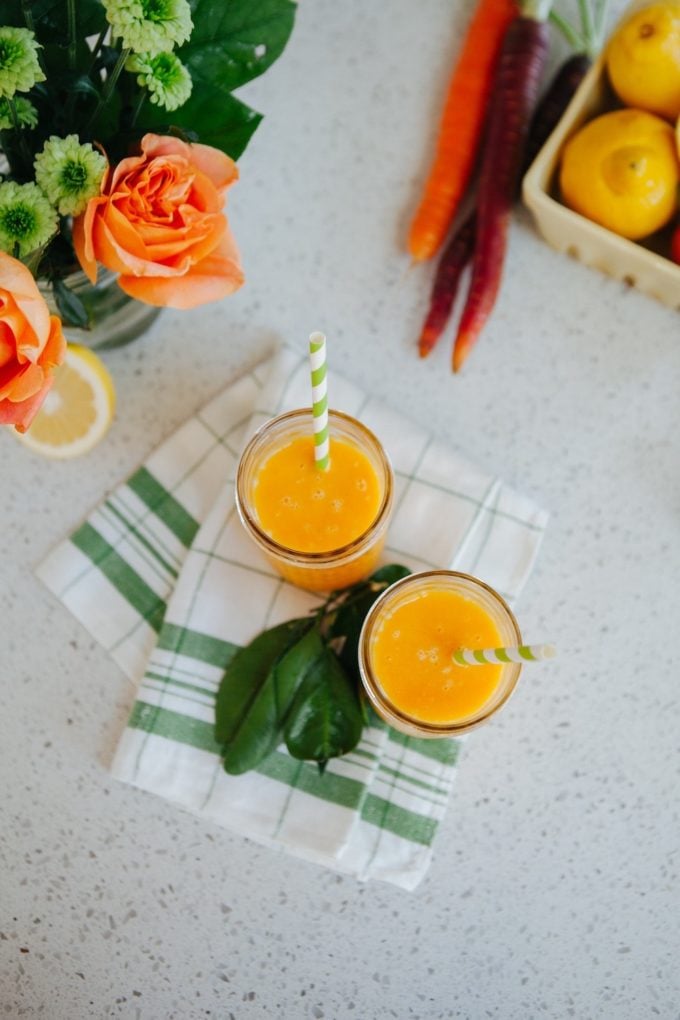Is Juicing Healthy? Advice from a Dietitian

Juice is taking a lot of heat these days – you can almost hear the rallying cry from health professionals (myself included) demanding it be taken off the food guide.
Developing right alongside this outcry, though, is the cold-pressed juice boom. Can these two positions healthfully co-exist? Yes…but this dietitian has to tell you that positioning commercial juice as the devil and a fresh vegetable juice as a faultless saint is not quite accurate either.
It’s a complicated picture…and I am going to get granular with it. But let’s start with some broad strokes: most commercial juices are concentrated sources of natural sugar, on par for sugar count with soda.
Stripped from its whole food home, sugar is sugar – don’t think you can guzzle commercial juices for hydration and it won’t have an effect on blood sugar. When you’re thirsty, it’s better to stick with water most of the time.
Juices are not the nutritional equivalent of their respective whole fruits and vegetables.
How could this be?
Let’s take the case of the humble orange. How long does it take you to peel, chew and swallow each individual segment? Ten minutes? In those ten minutes, you will have taken in about three teaspoons of naturally occurring sugar but that sugar is bound up in the plant cell walls so it won’t drastically spike blood sugars and the 2.5 g of fibre help fill you up.
Contrast that with orange juice. Let’s take one cup (250ml) of not-from-concentrate version to compare. You can gulp back the 6 teaspoons of sugar in that juice in 2 minutes. It won’t fill you up, and the lack of fibre and lack of time needed to digest it will send blood sugars soaring. And for the record, most bottles sold in a vending machine are 450 mL and have 11 teaspoons of sugars.
Do this every once in a while and it’s no big deal. Enjoy a bit of juice with a balanced meal, rich in protein and healthy fats, and it will minimize the glycemic impact.
But make a habit out of drinking big servings of fruit juices in between meals on a daily basis? Those blood sugar spikes will contribute to chronic inflammation, wreak havoc with appetite and energy levels, and increase cravings for more carbohydrates.
In addition, the heat processing and long term storage of juices will result in the degradation of certain nutrients, for example, vitamin C. We can’t be sure about the rainbow of important phytochemicals found in fresh produce – some, such as phenols, have been shown in the literature to remain present in processed juice while others are degraded rapidly. Note that many commercial juices have vitamin C added to them, which results in an impressive vitamin C content that wouldn’t be there otherwise.
Seems pretty clear that in a society where we are more sedentary than ever and have a hard time keeping our blood sugars in check, commercial juice should be an occasional drink, preferably eating alongside a meal, or mixed with sparkling water or used in a recipe.
Is juice always “bad”? The research says no.
As easy as it is to dismiss juice based on blood sugar effects, the research on the health benefits of juice, while inconclusive as a whole, provides some intriguing potential for including juice in your diet. We’re not talking apple juice here though.
One of the current stars in beet juice. Beet is high in compounds called betalains, which are present in the juiced version. It is also high in naturally-occuring nitrates. Human clinical trials on beet juice have shown promise in improving physical endurance, blood pressure and even blood sugar response.
Other potential juicy rock stars include pomegranate, kale, tart cherry and black currant. And yes, research is often done on commercial preparations…not fresh juice. But as I said, the evidence is not iron clad and considering our diabetes epidemic, I don’t know that I can confidently recommend every man, woman and child drink grocery store juice daily.
Especially when I can confidently recommend you pile your plate half full with vegetables at every meal – which I know will be even more nutritious.
Juice versus juicing…what’s the difference?
So where does juicing fit into all of this?
Juicing vegetables and fruits is a bit different (but not entirely). Straight out of the gate, you aren’t going to concentrate those liquids to amp up the sugars. You also aren’t heat processing some of the nutrients out of them so the potential for health benefits is higher. And when you choose more green veggies like kale, cucumber and spinach for your homemade or juice bar juice, the sugar content is going to be lower than a fruit forward juice.
How can you tell if you’ve hit the mark? The juice shouldn’t taste too sweet.
But juicing isn’t a free-for-all either!
Certain truths still hold – that when you juice, you lose some of the benefits of eating the whole fruit or vegetable. In addition, the pleasure – and satiety benefits – of eating actual food is lost. Human cannot survive (for long) on juice alone. Your body needs cleansing fibre, nourishing fats and strengthening protein to operate at optimal capacity. Which is why I like making blender juices, so you keep the fibre.
However, when you are juicing fresh vegetables it can help you boost your consumption of fresh produce – particularly if you don’t love to cook veggies – so it is a step in the right direction for a lot of people.
Fresh juices should retain more nutrients than commercial juices because you consume it (ideally) immediately or within a couple days of consumption. I was even able to find research comparing fresh juice with commercial juice, with the benefit handed to fresh juice.
What about juicing for weight loss?
Drinking something that provides liquid energy in the form of easily absorbable sugars isn’t the first place I would go to when it comes to weight loss. For me, a diet that promotes a healthy weight follows a protein + fibre pattern that keeps blood sugars stable and hunger at bay (and includes a TON of whole veggies). But where you are starting out is going to determine the impact of juicing on your health.
When I think of the success of people who improve their health and lose weight with juicing, I expect that much of that success is based on removing a lot of hyper-processed foods and fast foods and replacing it with far more nourishing fresh juices. At the end of the day, some people might be vastly increasing their nutrition and decreasing their calorie intake by juicing. So again, juicing can help improve your health…just ask your dietitian first, yes?
Bottom line: juicing wins…but it doesn’t beat whole food.
Here’s how to juice to enhance (not diminish) your health.
I will lay my cards on the table here: I enjoy drinking cold-pressed juice. It does feel healthy to me, despite the lack of research on juice versus the actual fruit and veg. I prefer veggie-heavy juices, with plenty of lemon or ginger. Beet is a favourite, as are green juices. Some cold-pressed green juices I have tried are way too sweet and I know there isn’t much veg there to speak of, despite the green colour.
However, I drink smoothies most often because I like to feel full, it’s a great lazy breakfast, and you can add fun additions like seeds, nuts and grains. Another great option is making a green blender juice, where you leave the fibre in.
So if you are looking to make juice a part of your life, here is how to do it right.
- A juice is NOT a meal. It’s a nourishing addition to your daily diet to help you eat more plants.
- Drink it slowly. A large juice should be sipped as slowly as you would eat a meal so as not to spike blood sugars.
- Try to get yourself to a ratio of 3 parts vegetable to 1 part fruit. The more greens you add, the lower the glycemic impact. Lemon also lowers glycemic impact.
- Watch your portions: if you aren’t active, don’t guzzle a pint of juice every day on top of your usual food intake.
- Don’t brush your teeth right after juicing…the acids will destroy your teeth.
- If you are juicing at home, you can take all of that pulp and repurpose it so you aren’t throwing out the nutrition. Add it to stews, muffins or even smoothie bowls and overnight oats.
- And finally, be wary of raw juicing if:
- You are pregnant or otherwise immuno-compromised. Raw juices are a technically a food safety risk, particularly because microbes can grow on juicers and then nothing will kill them if that juice is sitting around. It’s your choice, talk with your healthcare provider. Japanese ladies eat sushi while pregnant…French women won’t give up their cheeses. For me, I consume fresh juices from companies I trust to be immaculately clean. There aren’t a lot of them.
- You have diabetes. Juices are generally off the table if you are having trouble keeping blood sugars in check. If you really love fresh juices and are trying to use them to get healthier, consider drinking small servings (less than 1 cup) with a protein heavy meal to moderate the absorption of sugars.



4 Comments on “Is Juicing Healthy? Advice from a Dietitian”
Very informative! Thanks for sharing 🙂 I’m new to the vegetarian lifestyle and I just discovered your website and TV show. Lovvvve it!! I’d love to include more juice in my life-Can you recommend a basic juicer that’s simple to operate and affordable?
Thank you so much for watching Lisa! I haven’t bought a juicer in a while so I am not as sure what is out there – but I have a few Breville products and I find them high quality so I might give theirs a go! On the show, I use Omega…they are really great too but pricier.
Hi Desiree.
I’d like to know what juicer you use, because I’m interested in juicing.
Hi! I don’t actually have a juicer anymore…I make blender juices now. But I like the omega juicers, they’re fantastic!